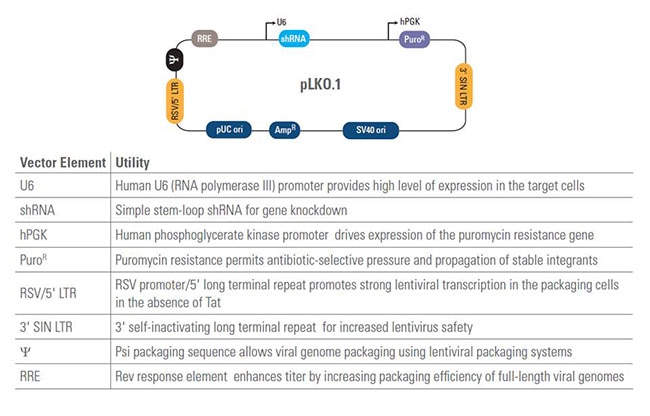- Gene modulation
- RNA interference
- Short hairpin RNA (shRNA)
- TRC Lentiviral shRNA Controls
TRC Lentiviral shRNA Controls
TRC positive and negative shRNA controls for a well-designed gene silencing experiment

The RNAi consortium (TRC) is a collaborative effort based at the Broad Institute of MIT and Harvard, and includes six MIT- and Harvard-associated research institutions and five international life sciences organizations. We have partnered with the TRC to make the shRNA libraries available to researchers worldwide. Available TRC shRNA controls include the pLKO.1 empty vector as a negative control and an eGFP shRNA as a positive control.
The pLKO.1 controls can be packaged into virus particles for use in transduction experiments. Specifically, the replication-incompetent viral particles can be efficiently produced using lentiviral packaging plasmids co-transfected in 293T packaging cells. The Trans-Lentiviral packaging system, which offers maximum biosafety and high titers, is recommended.
Highlights
- Rules-based shRNA design for efficient gene knockdown
- Already cloned into lentiviral vectors
- Amenable to in vitro and in vivo applications such as the creation of stable knockdowns
- Lentiviral vector enables transduction of primary and non-dividing cell lines
- Broad coverage: 4 to 5 constructs per gene
Further information is available at http://www.broad.mit.edu/genome_bio/trc/rnai.html
Citing the library in Scientific Publications
In scientific publications, the libraries should be referred to as TRC-Hs1.0 (Human) and TRC-Mm1.0 (Mouse). Individual clones are uniquely identified by their TRC ID number (eg. TRCN0000014783).
The TRC lentiviral shRNA libraries are provided in 96-well microtiter plates containing frozen stock cultures of E. coli in 2XLB broth with 8% glycerol and carbenicillin (100 µ/ml). We check all cultures for growth prior to shipment. Individual shRNA constructs are shipped as glycerol stock cultures on wet ice.
pLKO.1 lentiviral vector

- J. Moffat et al., A Lentiviral RNAi Library for Human and Mouse Genes Applied to an Arrayed Viral High-Content Screen. Cell.124, 1283-1298 (2006).
- S. A. Stewart et al., Lentivirus-delivered stable gene silencing by RNAi in primary cells. RNA. 9, 493-501 (2003).
- R. Zufferey et al., Multiply attenuated lentiviral vector achieves efficient gene delivery in vivo. Nat. Biotechnol.15, 871-885 (1997).
- R. Zufferey et al., Self-inactivating lentivirus vector for safe and efficient in vivo gene delivery. J Virol. 72, 9873-9880 (1998).
- T. Yamamoto, Y. Tsunetsugu-Yokota. Prospects for the therapeutic application of lentivirus-based gene therapy to HIV-1 infection. Curr. Gene Ther. 8(1), 1-8 (2008).
Safety data sheets
Technical manuals
Related Products
The RNAi Consortium, or TRC, is a public-private effort based at the Broad whose mission is to create a shRNA library to enable the scientific community to use RNAi to determine the function of human and mouse genes.
The RNAi Consortium, or TRC, is a public-private effort based at the Broad whose mission is to create a shRNA library to enable the scientific community to use RNAi to determine the function of human and mouse genes.
